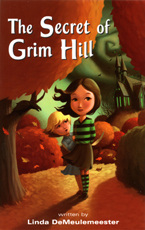 The Secret of Grim Hill by Linda DeMeulemeester
Lobster Press, 2007
Cat and her younger sister, Sookie, have just moved to a new town with their mother, and Cat is not enjoying Darkmont High at all. Soccer-playing Cat soon finds out about soccer scholarships to the nearby private Grimoire school that are earned by the winning team of a Halloween match. Despite continually hearing from Sookie and their neighbour, Jasper, that something just isn't right about Grimoire, Cat goes ahead with her daily team practices until the bizarre events of an early Halloween party change her priorities.
I was spurred to read The Secret of Grim Hill by a new student who wondered if the library had the sequels because he enjoyed this book so much. He reads a lot and very quickly, so I thought if he liked it then it must be pretty good. Happily, it is.
Cat is a realistic tween protagonist: she is easily annoyed by her younger sister, very aware of her school's social hierarchy and endeavours to climb it, fulfills her household responsibilities despite wishing she didn't have to, and is quintessentially likable. When push comes to shove, Cat's priorities are in order (soccer and family at the top with homework dead last). Sookie is as much or even more compelling as a precocious, Monopoly-loving little girl who is generally as seemingly as annoyed with Cat as Cat is with her.
The atmosphere of Grim Hill is generally light with escalating indications to the reader that something dark is afoot. DeMeulemeester's incorporation and explanations of Celtic mythology and traditions are seamlessly done, and the tension builds to a peak that is exhilarating and urgent but not full-on scary. I look forward to reading one or more of the sequels (loaned from another school library for the student mentioned earlier) to see if the Celtic theme is maintained or if other mythologies are incorporated into the series.
Overall, a solid beginning to a middle-grade fantasy series.
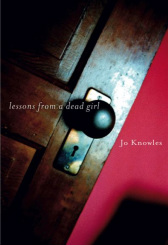 Lessons from a dead girl by Jo Knowles
Candlewick, 2007
Beautiful, popular Leah takes awkward Laine under her wing when they are in fifth grade and declares them to be friends forever. Laine is confused by the attention but happily goes along with it. Laine even goes along with Leah's insistence that they secretly "practice" for marriage together, although Laine becomes increasingly confused by what it means about her relationship with Leah. While the girls grow apart as they enter high school, Leah maintains a powerful hold over Laine until a public confrontation results in tragedy.
Knowles tackles the topic of sexual abuse between children head-on, and she does it with a remarkably delicate touch while pulling no punches. Laine's confusion and desperation to keep Leah happy, as well as the tension between Laine and Leah in the years after their "practice" ends, are well-rendered. Although there are certainly scenes that are uncomfortable as a reader, nothing is graphically presented and the narrative focuses primarily on the emotions of the characters, especially Laine as the novel is from her point of view.
Leah and Laine are three-dimensional characters with specific and evident motivations, and their respective evolutions as they grow into teenagers are unsurprising but nonetheless poignant. Although I know very little about this topic, it would appear that the author did a good deal of research to create such believable characters, and this novel was an emotional and educational introduction to the subject and will not soon be forgotten.
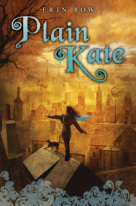 Plain Kate by Erin BowArthur A. Levine Books (Scholastic), 2010Let me start at the end: I was reduced to not a slightly teary, not a delicately weepy, but a blubbering, sobbing mess at the end of this book. I haven't cried so much because of a book since I struggled to read the last chapters of Tolkien's The Return of the King through a veil of tears, a comparison which may give you an indication of both how invested I was in the characters and the effectiveness of Bow's world-building. Bow's prose certainly reflects the fact that she is a published poet, with phrases like "the sky had slid shut under a lid of low clouds" (p. 30) appearing throughout. This lyricism lent itself well to the dark, magical world that Plain Kate inhabits and tries her best to make her way safely through. The book is very atmospheric, and I could almost feel the cold damp of the fog traveling upriver, or hear the mud pulling at the bottom of Plain Kate's boots. The novel has a distinct Medieval, Eastern European feel to it, with towns and cities located at great distances from one another and tinkers and merchants selling their wares in outdoor markets.Plain Kate is an evocative main character. She reveals herself slowly to other characters as well as to the reader, and coming to know her gradually made her feel all the more real. Her constant companion, Taggle the cat, is a wonderful comic foil to Plain Kate's seriousness while remaining an exceedingly loyal companion (despite his derision for dogs). Secondary characters, such as Drina and Behjet, are three-dimensional with their own tangled beliefs and personal sorrows that are hinted at and not always explained, leaving the reader to draw their own conclusions. As in reality, people and events were not always tied up neatly, which makes it easier to believe that the world in Plain Kate has no boundaries and continues to exist. Although it took me a few dozen pages to get truly sucked into Plain Kate, once I was in it I wasn't prepared to leave until I got to the end. Had someone asked me after the first chapter if I would be an emotional wreck at the end of the book, I would have given a definitive no. I am exceedingly glad that I would have been wrong, and I will be recommending this book to many. Edited February 15th to add: I just found a fantastic book trailer for Plain Kate made by Scholastic:
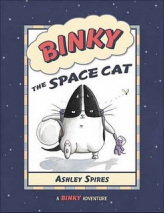 Binky the space cat by Ashley Spires
Kids Can Press, 2009
This book is hilarious and I adore it. That is all.
No, not really, but that is definitely my overall sentiment about this graphic novel for elementary-age children. Binky the cat, who trains ceaselessly (except for napping and eating, of course) to become an effective space cat who keeps the omnipresent "aliens" (bugs) away from his humans, has fast become my favourite cat in children's fiction.
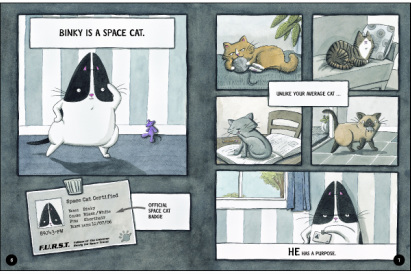 Image from: http://www.kidscanpress.com/US/Binky-the-Space-Cat-P3150.aspx The humour in this book is spot on, especially for anyone who has spent much time with a cat and knows their habits and quirks. The pages when Binky tries to help out around the house but manages to do quite the opposite is a hoot, as are Binky's attempts to dote on his humans. It has a Toy Story sensibility in the sense that Binky pursues his projects under the humans' noses without their knowledge, partaking in nighttime raids and research on the sly, complete with reading glasses stowed under the chair cushion. While some of the subtler jokes probably won't be caught by children, like the cover image homage to the inevitable slow-motion scene in Apollo 13 and the like wherein the astronauts stride heroically toward the spacecraft prior to take-off, Binky's "space gas" from eating particularly crunchy bugs will definitely get some giggles. Again, loved it, and I can't wait to get my hands on any other Binky books out there.
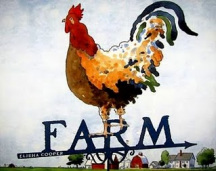 Farm by Elisha Cooper
Orchard Books (Scholastic), 2010
Farm takes readers from early spring through to late autumn on a modern family farm. Although it is strictly speaking a fictional picture book, Farm reads much like nonfiction with it's descriptive chronological text. At the end, I felt as if I had watched a months-long, time-lapse film of the farm.
Cooper's text, while concise, results in a very atmospheric book. Phrases like "even the clouds seem to make sound as they bump across the sky"* and "to the south are more cornfields, which smell sort of buttery" permeate the book with evocative details of farm life. It is these details, the minutiae of farm life from squeaking corn to the smell of the barn, that made me feel as if I had been there. Despite the detail the text manages to show the reader instead of telling them, leaving me to fill in blanks.
The use of white space in the watercolour illustrations also reflect this sense of filling in blanks. From the farm animals to the children doing chores, all are illustrated with a stark white background, and without much detail except for some animal close-ups. The feeling of wide open spaces is tangible when Cooper shows panoramas of the farm, which are dominated by the sky filling the vast majority of the page.
A subtle humour is at play as well, which I enjoyed: describing the lazy activities of the month of June, "Bear [the cat] plays with a snake then eats it (some animals enjoy June more than others)." A bit dark? Sure. But the cycle of life is alluded to every so often in Farm, and rightly so.
This is a poetic and evocative book about the day-to-day, season-to-season life on a family farm. Lovely.
*I would provide page numbers for quotes but the book is not paginated.
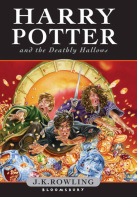 Harry Potter and the Deathly Hallows by J.K. Rowling
Raincoast Books, 2007
Admittedly, it is a source of youth librarian shame that I haven't read the final Harry Potter book until now, years after it was published. Better late than never, I suppose!
As the last book in the ground-breaking series, I had high hopes for this novel, and for the most part I wasn't disappointed. The characters remained as consistent as always, loose ends were tied up, and tension and suspense permeated the entire novel. I particularly enjoyed learning about Dumbledore's past and watching Harry grapple with what he should believe about his mentor. I have also been curious about Snape's true motivations and that, too, was revealed.
My favourite parts of the novel were the lighter bits, of which there were few. The Weasley family as a whole are the group of characters I enjoy the most throughout the series, especially the family dynamics and Fred and George's antics, and the funnier moments in the book almost invariably involved one Weasley or another.
One thing I have always admired about Rowling's writing is her ability to keep information hidden from both the book's characters and the reader, while making the thread of logic and discovery make complete sense once the revelation comes out. One of my gripes about some children's literature is that crucial bits of information are terribly obvious to the reader but the characters just can't seem to see what is right in front of their noses, and this often frustrates me. I have never had this frustration with Rowling.
*Spoilers ahead* My one gripe about this book is the climatic final battle between Harry and Voldemort. For something that has taken seven books and thousands of pages to come to a head, I found it disappointing. While most of their direct conflicts involved Harry surviving due to a twist of logic or something Voldemort forgot about, the final battle between the two seemed very quick and wordy and (again) involved something Voldemort didn't consider in his calculations and his overall underestimation of Harry. While I can see a lesson there about arrogance vs. reflection, etc., and while I suppose the only way anyone could have defeated Voldemort was by finding holes in his plan and capitalizing on them, the climax wasn't as epic as I would have liked. Sure, there was a Death Eaters and Dementors versus Order of the Phoenix and Hogwarts students battle, but even that was a sideline event. While the pace at the end was breathless and I was very happy to see the end of the Dark Lord, there was something missing for me. *End spoilers*
This is not to say that I wasn't completely sucked into the book for its entirety - in fact, for the final 200 pages I could not bear to put the book down. Perhaps my reaction to the finale was due to the late (early?) hour, but on the other hand I appreciated the epilogue and thought it was an appropriate book-end to the very beginning of Harry's story: on platform 9 3/4. Overall, a satisfying conclusion to a wonderful series.
|







 RSS Feed
RSS Feed